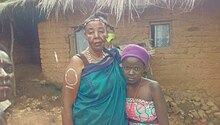 | |
| Total population | |
|---|---|
| 615,000[1] | |
| Languages | |
| Kifuliiru, Kiswahili, French, and English | |
| Religion | |
| Christianity, Fuliiru Religion, Islam, and Irreligious | |
| Related ethnic groups | |
| Vira, Nyindu, Bashi |
| Person | Mufuliru |
|---|---|
| People | Bafuliru |
| Language | Kifuliru |
| Country | Bufuliru |
The Fuliru people (also spelled Fuliiru) are a Bantu ethnic group predominantly inhabiting the east-central highlands of the Democratic Republic of the Congo (DRC).[2][3][4] They reside in the South Kivu Province, situated south of Lake Kivu and to the north and northwest of Uvira Territory, along the Ruzizi Plain near the border with Rwanda and Burundi, where a contingent of Fuliru also resides.[5][4][6] According to the 2009 census, their population estimate exceeded 250,000,[2] while a 1999 estimate of Kifuliru-language speakers placed the number at 300,000.[4] The Fuliru are renowned for their skilled craftsmanship, particularly in the production of pottery and basketry. Their handcrafted baskets are highly coveted for their intricate designs and exceptional quality, and are frequently employed for storage, decoration, and even as musical instruments.[7]
The Fuliru, like many other communities in the eastern part of the DRC, face ongoing challenges related to access to basic needs such as clean water, healthcare, and education. Parenthetically, they face issues related to land disputes, political marginalization, and human rights abuses. The Fuliru women and girls are particularly vulnerable to sexual and gender-based violence amplified by the region's persistent armed conflicts, which have resulted in the prevalence of a pervasive culture of impunity.[8][9][10][11]
- ^ "Fuliro in Congo, Democratic Republic of". Joshua Project. Retrieved 8 August 2023.
- ^ a b "Fuliiru." Encyclopedia of the Peoples of Africa and the Middle East, Volume 1 (Jamie Stokes, editor) (2009). Infobase: p. 234.
- ^ Johan Pottier, Re-Imagining Rwanda: Conflict, Survival and Disinformation in the Late Twentieth Century (2002). Cambridge University Press: p. 16.
- ^ a b c "Furiiru." Ethnologue: Languages of the World (16th ed) (2009). M. Paul Lewis (editor), 2009. Dallas: SIL International.
- ^ James Stuart Olson, The Peoples of Africa: An Ethnohistorical Dictionary. Greenwood: 1996, p. 183.
- ^ "Africa Report" (Vol. 10), African-American Institute, p. 9
- ^ Hautmann, Frédéric (1939). "Étude ethnographique de l'Itombwe (district du Kivu, Congo Belge)". Geographica Helvetica (in French). 4 (3): 175–176. doi:10.5194/gh-4-175-1949. S2CID 180994095.
- ^ "Sud-Kivu : près de 90 % de déplacés internes de Bafuliiru regagnent leurs villages". Radio Okapi (in French). 2022-07-08. Retrieved 2023-05-11.
- ^ "Uvira : les déplacés de Bwegera appellent le gouvernement à assurer leur sécurité". Radio Okapi (in French). 2022-06-10. Retrieved 2023-05-11.
- ^ "Sud-Kivu: la population de la Ruzizi bénéficie d'une coopérative laitière financée par la MONUSCO". Radio Okapi (in French). 2022-02-10. Retrieved 2023-05-11.
- ^ "Sud-Kivu: la présence des groupes armés à Lemera inquiète l'autorité coutumière". Radio Okapi (in French). 2022-02-11. Retrieved 2023-05-11.